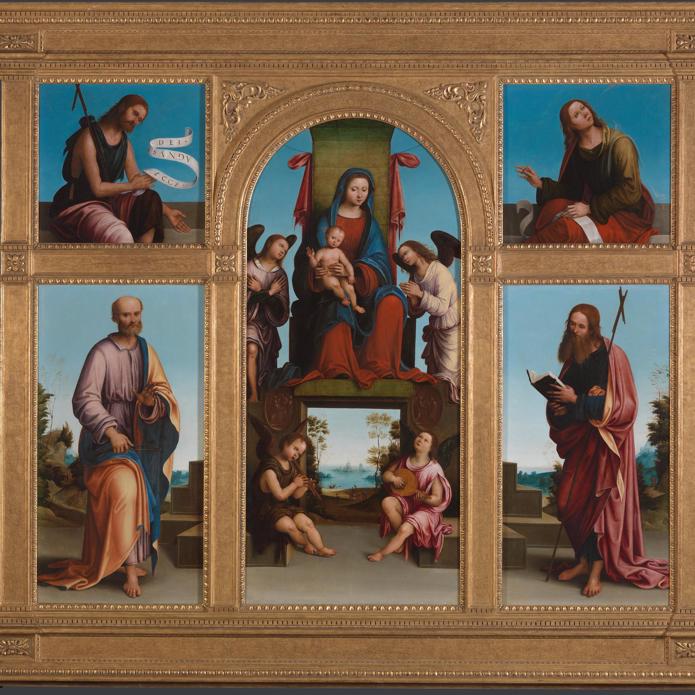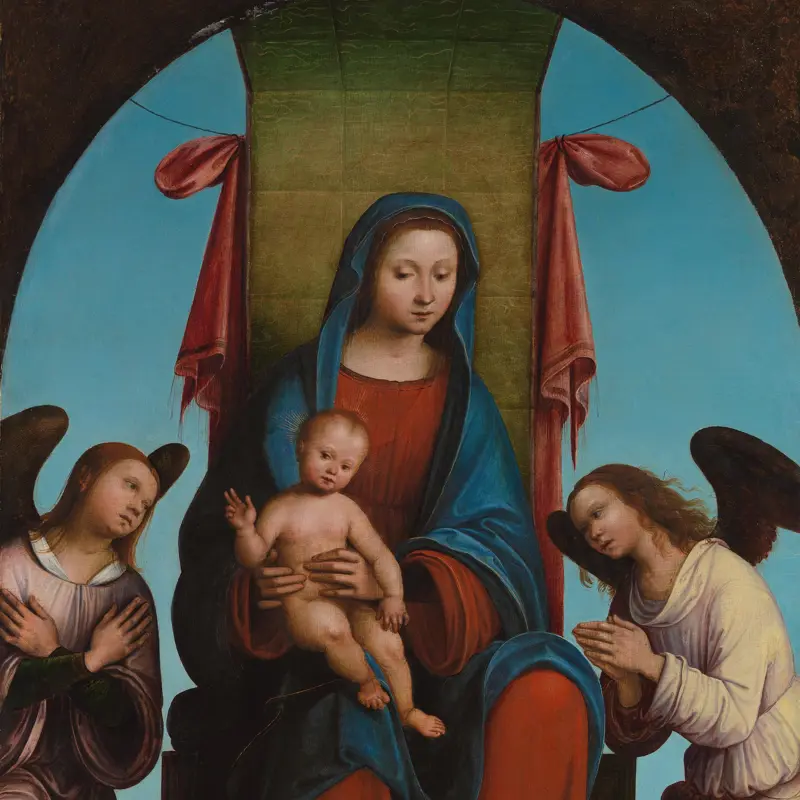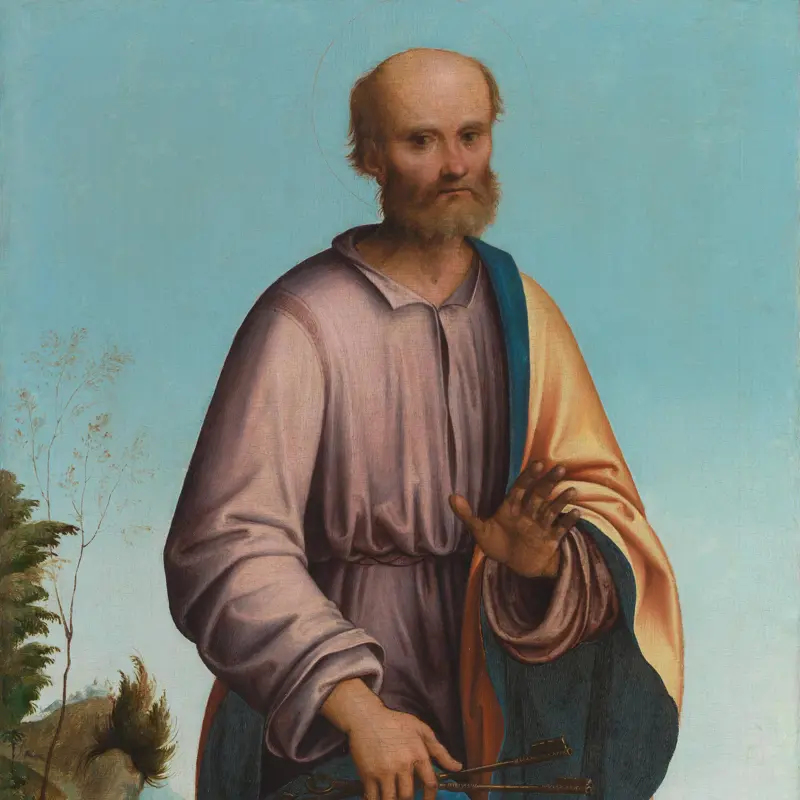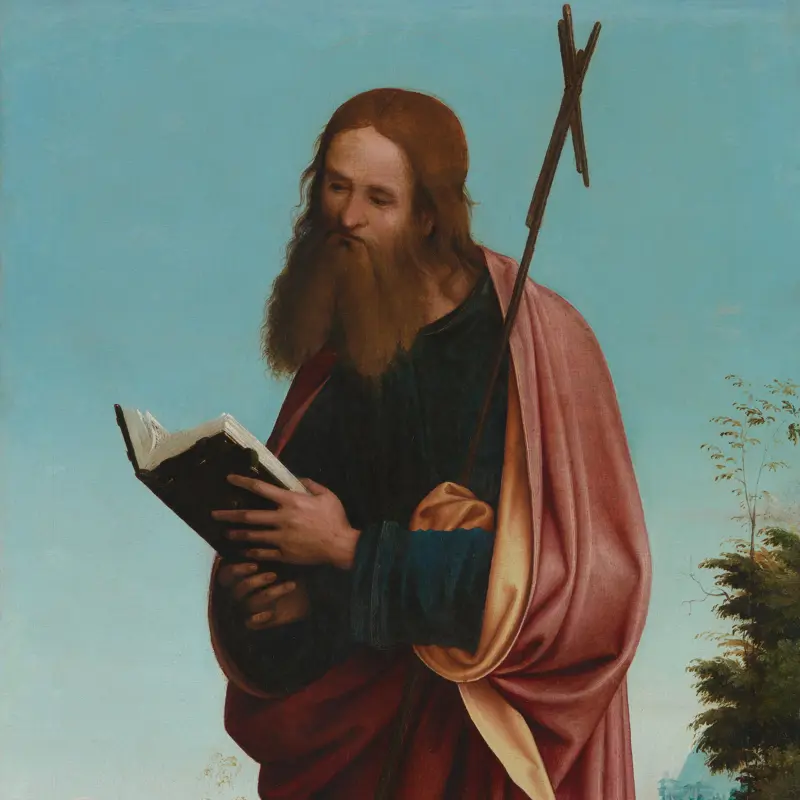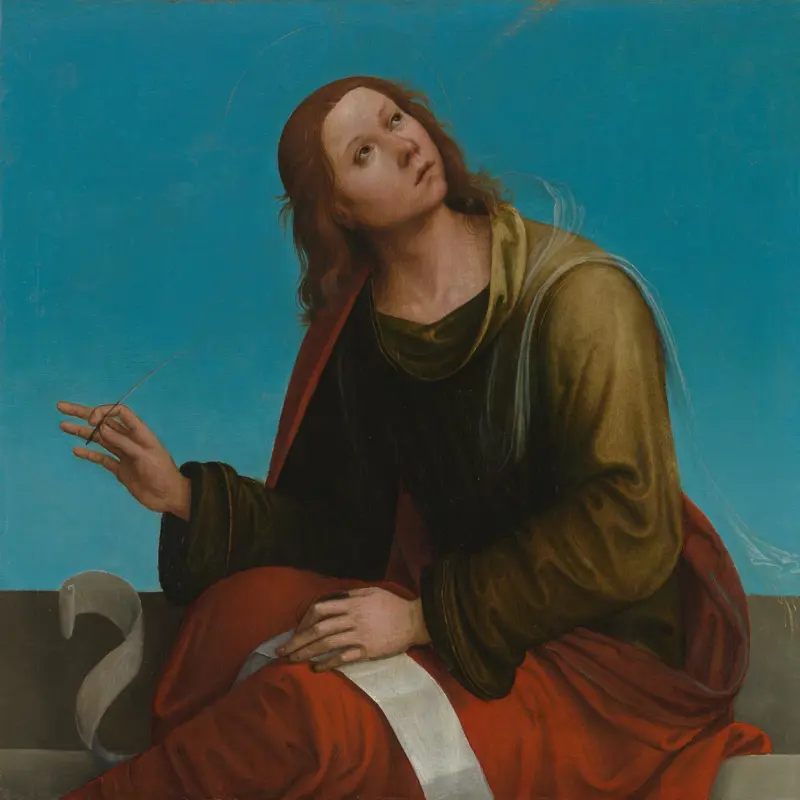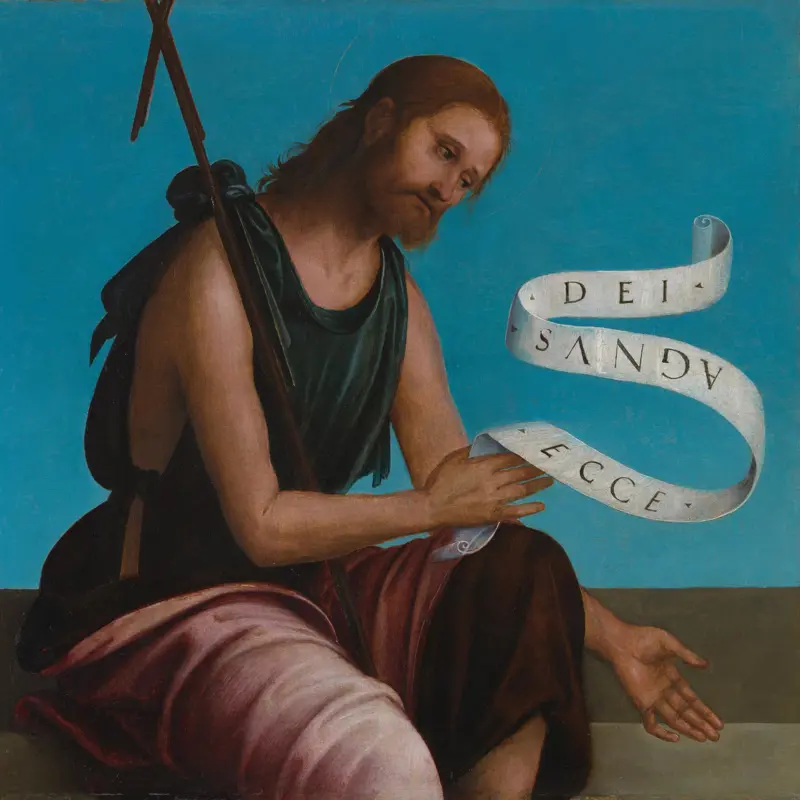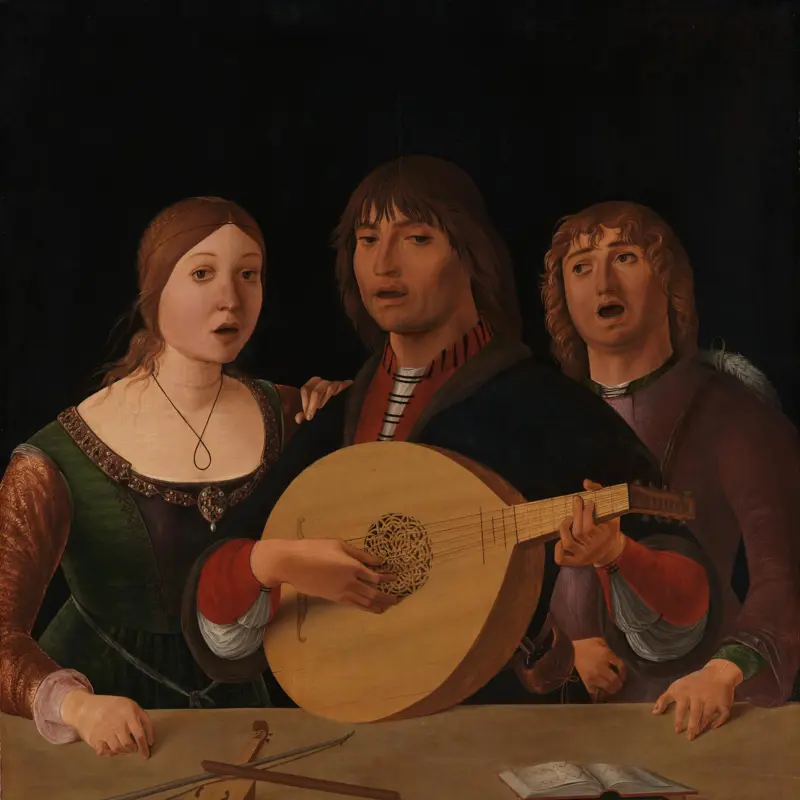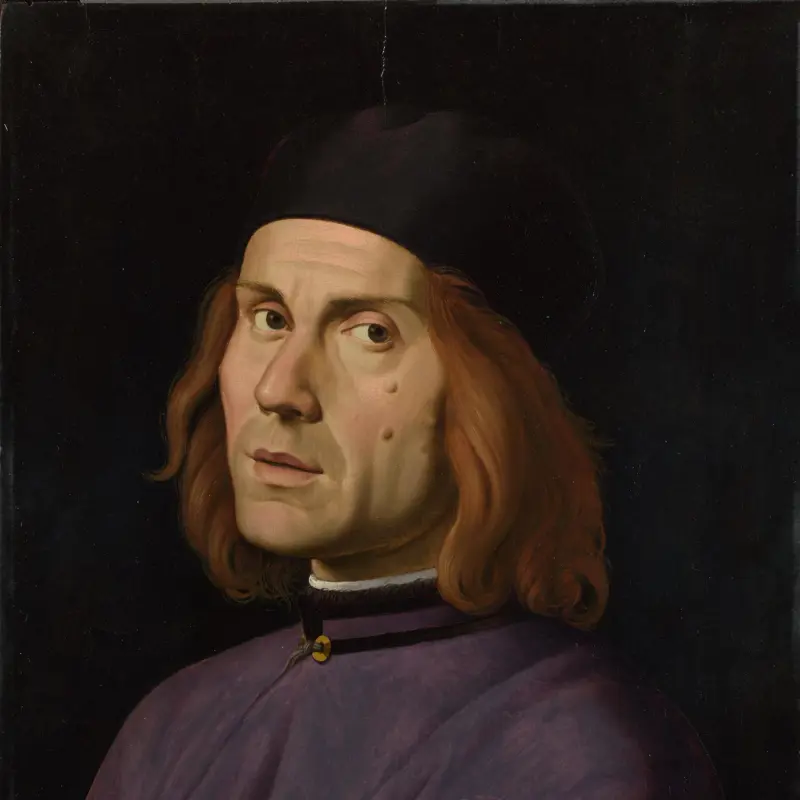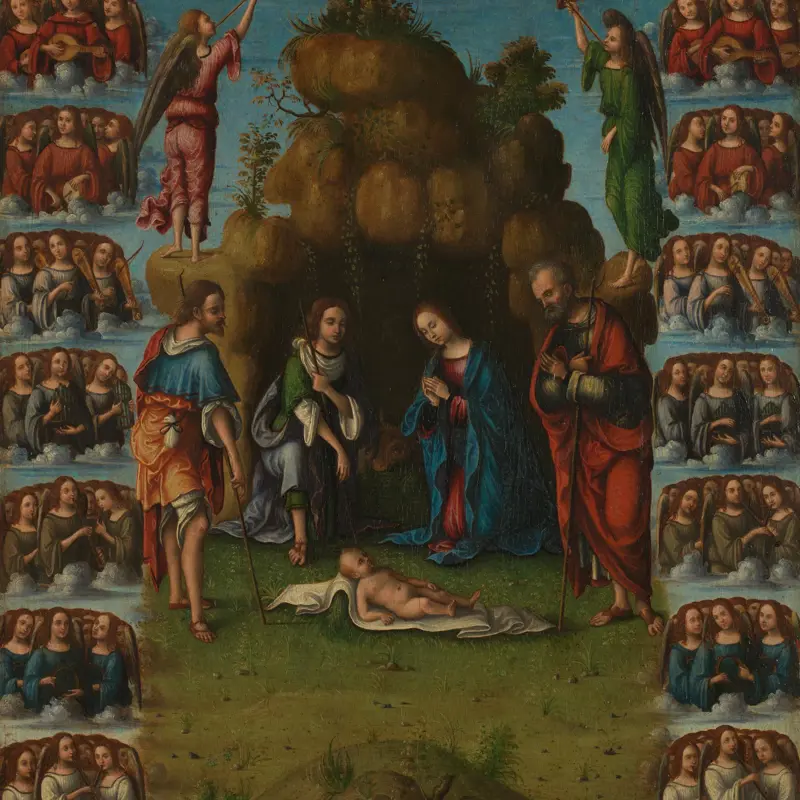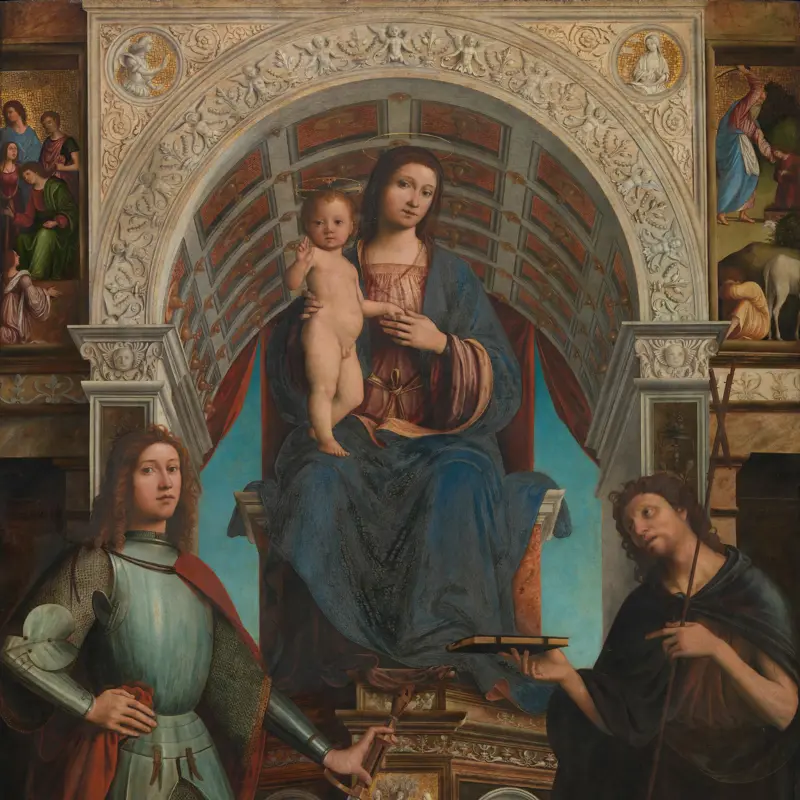Lorenzo Costa, 'The Virgin and Child enthroned with Angels', 1505
About the work
Overview
This painting of the Virgin and Child enthroned was once the central element of a large multi-panelled altarpiece made for the oratory of S. Pietro in Vincoli, Faenza. In it, heaven and earth mingle. The Virgin is depicted as Queen of Heaven, although she has no crown: behind her is a green silk cloth of honour, such as was hung behind medieval and Renaissance royalty.
The front edge of the cloth hangs down over the lintel of an elegant but implausible stone structure with a doorway at its centre. On either side of the doorway, oval reliefs show the presentation of the Virgin in the Temple and the marriage of the Virgin; through it, we can see an imaginary landscape.
A fascination with complex stepped architecture had long been a feature of Ferrarese painting, and Costa in 1497 had devised a similar, though even more elaborate, architectural structure for the Ghedini chapel (S. Giovanni in Monte, Bologna).
Key facts
Details
- Full title
- The Virgin and Child enthroned with Angels
- Artist
- Lorenzo Costa
- Artist dates
- 1460 - 1535
- Part of the group
- The High Altarpiece from San Pietro in Vincoli, Faenza
- Date made
- 1505
- Medium and support
- Oil, originally on wood, transferred to canvas
- Dimensions
- 167.6 × 73 cm
- Inscription summary
- Signed; Dated and inscribed
- Acquisition credit
- Bought, 1859
- Inventory number
- NG629.1
- Location
- Room 61
- Collection
- Main Collection
Provenance
Additional information
Text extracted from the ‘Provenance’ section of the catalogue entry in Giorgia Mancini and Nicholas Penny, ‘National Gallery Catalogues: The Sixteenth Century Italian Paintings’, vol. 3, ‘Bologna and Ferrara’, London 2016; for further information, see the full catalogue entry.
Bibliography
-
1780J.A. Calvi, Versi e prose sopra una serie di eccellenti pitture posseduta dal signor marchese Filippo Hercolani, Bologna 1780
-
1822G.G. Bottari and S. Ticozzi, Raccolta di lettere sulla pittura, scultura ed architettura: Scritta da' piu celebri personaggi dei secoli XV, XVI e XVII, 8 vols, Milan 1822
-
1844G. Baruffaldi, Vite de' pittori e scultori Ferraresi, ed. G. Boschini, Ferrara 1844
-
1856C. Laderchi, La pittura ferrarese, Ferrara 1856
-
1901A. Venturi, Storia dell'arte italiana, 11 vols, Milan 1901
-
1962Gould, Cecil, National Gallery Catalogues: The Sixteenth Century Italian Schools (excluding the Venetian), London 1962
-
1967R. Varese, Lorenzo Costa, Milan 1967
-
1975C. Gould, Delaroche and Gautier: Gautier's Views on the 'Execution of Lady Jane Grey' and on other Compositions by Delaroche, London 1975
-
1977C.M. Brown, Lorenzo Costa, Ann Arbor 1977
-
1977P. Tosetti, 'Lorenzo Costa', University of Padua: Annals of the Faculty of Arts and Philiosophy, II, 1977
-
1987Gould, Cecil, National Gallery Catalogues: The Sixteenth Century Italian Schools, London 1987
-
1990C. Bernardini, Il Bagnacavallo Senior: Bartolomeo Ramenghi, pittore (1484?-1542?), Rimini 1990
-
1991J. Dunkerton et al., Giotto to Dürer: Early Renaissance Painting in the National Gallery, New Haven 1991
-
1993A. Colombi Ferretti, 'Una proposta per gli esordi di Bagnacavallo di Vecchio', Arte a Bologna: bollettino dei Musei Civici d'Arte Antica, III, 1993, pp. 64-79
-
2001
C. Baker and T. Henry, The National Gallery: Complete Illustrated Catalogue, London 2001
-
2016Mancini, Giorgia, and Nicholas Penny, National Gallery Catalogues: The Sixteenth Century Italian Paintings, 3, Bologna and Ferrara, London 2016
About this record
If you know more about this work or have spotted an error, please contact us. Please note that exhibition histories are listed from 2009 onwards. Bibliographies may not be complete; more comprehensive information is available in the National Gallery Library.
Images
About the group: The High Altarpiece from San Pietro in Vincoli, Faenza
Overview
These five paintings were once part of a large multi-panel altarpiece, or polyptych, made for the high altar of the Oratory of S. Pietro in Vincoli, Faenza. It was originally topped by a horizontal panel, now lost, showing the dead Christ supported by angels.
Although the altarpiece has been dismembered and its original frame – an important part of the ensemble – is lost, we can tell how it would have been arranged by comparison with existing polyptychs and designs for them, and from the paintings themselves. The Virgin and Child evidently appeared in an arched niche: the dark curved areas to either side of the Virgin’s head would have been covered by the frame. They were flanked by Saints Peter and Philip in the lower register, with Saints John the Evangelist and John the Baptist above.
Lorenzo Costa has signed and dated the central panel in Latin, making it look like an inscription at the top of the door frame: LAURENTIUS COSTA F[ECIT] 1505.

